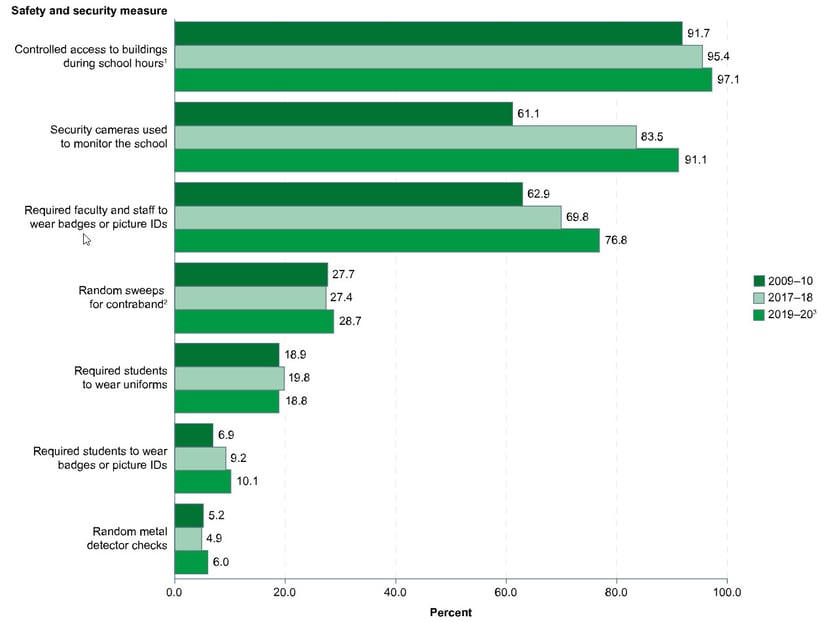Keeping students and staff safe is a fundamental promise to our communities. The evolving nature of threats to our schools demands a sophisticated and layered approach to security and emergency preparedness. This approach is not just about reacting to incidents, but preemptively setting up defenses that can mitigate or help prevent these situations. Central to this security framework is access control and visitor management systems for K-12 schools, which serve as the bedrock for safeguarding educational institutions.
Percentage of public schools that used selected safety and security measures: School years 2009–10, 2017–18, and 2019–20

Source: NCES
Understanding the Layers of Security
Security in K-12 schools, as outlined by the Partner Alliance for Safer Schools (PASS) Guidelines, emphasizes a comprehensive security model. This model includes multiple layers, from districtwide policies to classroom doors, each designed to work together to protect the school community. Among these, two of the most pivotal layers involve managing who gets into our schools and how their presence is monitored—this is where access control and digital visitor management systems come into play.
Access control and visitor management system for K-12 schools are integral components of this security model, ensuring that only authorized individuals can enter and navigate school premises. By meticulously managing entry points and visitor access, schools can significantly mitigate the risks of potential security breaches.
The Evolution of Access Control in Schools
Traditionally, access control in schools relied on physical keys and locks, which presented limitations in terms of flexibility and security. Today, digital access control systems have transformed this scenario, offering dynamic solutions that can be tailored to the unique needs of each educational institution. These systems provide the ability to control access based on specific criteria such as time, location, and the individual's role within the school, thereby enhancing security and operational efficiency.
Integration of Advanced Technologies
Modern access control systems in schools have embraced advancements in technology, integrating features such as biometrics, mobile access, and cloud-based digital visitor management systems for K-12 schools. These enhancements have not only improved the security of access control systems but have also introduced convenience and efficiency into the management of school security. Biometric systems, for instance, use unique physical characteristics, making unauthorized access exceedingly difficult. Mobile access control allows staff and students to use their smartphones as access keys, streamlining the entry process and reducing the need for physical key management.
Real-time Monitoring and Incident Response
The integration of real-time K-12 incident management software for monitoring represents a leap forward in school security. Modern access control and emergency management system for K-12 schools can alert administrators to unauthorized access attempts and monitor entry points continuously. This capability enables immediate response to potential security breaches and enhances the overall safety of students and staff.
Key Benefits of Digital Visitor Management Systems
- Enhanced Security and Control: The adoption of visitor management system for K-12 schools has become increasingly prevalent, with the share of public schools controlling access to buildings rising to 97% over the past decade. This demonstrates a clear commitment to enhancing school safety by closely monitoring and controlling who enters the premises.
- Operational Efficiency: Automate the visitor check-in process, reducing wait times and freeing up administrative resources.
- Compliance and Reporting: Easily generate reports for compliance audits and review visitor data to improve security protocols.
- Improved Communication: Notify staff of visitor arrivals and manage emergencies more effectively through integrated communication tools.
- Integration with Advanced Security Measures: Digital visitor management systems for K-12 schools have evolved to integrate seamlessly with other security measures, including background checks and surveillance systems. This comprehensive approach ensures that only authorized individuals can access the school, thereby significantly reducing the risk of unauthorized or potentially dangerous individuals entering.
- Effective Visitor Screening: The ability to instantly screen visitors using driver’s licenses or ID cards against national databases, including sex offender registries and criminal records, provides a critical layer of security for K-12 schools. This instant screening helps prevent individuals with a known history of offenses from entering school grounds, directly contributing to a safer environment for students and staff.
- Custodial Rights Verification: By confirming custodial rights through visitor management system for K-12 schools, school authorities can prevent students from leaving with unauthorized individuals, mitigating the risk of potential abduction or exposure to harm. This feature is especially critical in navigating complex custody disputes and ensuring student safety during school hours and events.
- Improved Compliance and Reporting: The automated nature of digital visitor management systems for K-12 schools streamlines the check-in process, enhancing operational efficiency and ensuring compliance with safety protocols. These digital visitor management systems also facilitate easy generation of reports for compliance audits, enabling schools to review and improve their security measures continuously.
Federal Guidelines and Best Practices
In response to the growing need for stringent security measures in schools, federal agencies have established guidelines and resources to support educational institutions in developing and implementing effective security strategies. The Partner Alliance for Safer Schools (PASS) provides a comprehensive set of best practices for K-12 security, emphasizing the importance of layered security measures, including access control and visitor management.
Furthermore, the Cybersecurity and Infrastructure Security Agency's (CISA) 3rd edition of the K-12 School Security Guide provides more comprehensive and actionable insights for K-12 schools seeking to bolster their security infrastructure.
Systems-Based Approach for Layered Security
Comprehensive Security Planning: Schools should adopt a systems-based approach to security, tailoring strategies to their unique settings. This holistic method ensures that physical security integrates seamlessly with prevention, protection, mitigation, response, and recovery efforts, creating a safer learning environment without overwhelming staff with security expert duties.
Emphasis on Multidisciplinary Collaboration
Collaborative Security Planning: Stressing the value of a multidisciplinary approach, the guide advises schools to involve a broad spectrum of stakeholders in the security planning process. This includes educators, administrators, local law enforcement, and the broader school community, ensuring that all perspectives are considered and that the implemented strategies are comprehensive and inclusive.
Conclusion
The safety of our schools is a collective responsibility that demands attention, commitment, and continuous improvement. By embracing advanced visitor management system for K-12 schools and adhering to federal guidelines, K-12 schools can fortify their defenses against a wide array of threats and security breaches.
Access control and digital visitor management systems for K-12 schools are not just tools but essential components of a broader strategy to ensure the well-being of students and educators alike. In this endeavor, every layer counts, and every measure contributes to the creation of a secure and nurturing educational landscape.
Explore how Kokomo24/7® HOST™ can transform your school's security approach. Learn more about our visitor management system for K-12 schools guest screening and tracking solutions and take a proactive step towards comprehensive school safety.
Kokomo24/7® stands at the forefront of compliance and risk management solutions, dedicated to enhancing health and safety across a variety of settings. With a deep commitment to ensuring school safety, Kokomo has a significant track record across Fortune 1000 companies as well as notable public-sector entities and educational institutions such as Chicago Public Schools. Ask us about the time we helped host the Oscars!

 CASES™
CASES™ ESCALATE™
ESCALATE™ TRIAGE™
TRIAGE™ NOTIFY™
NOTIFY™ FORMS™
FORMS™ ANALYTICS™
ANALYTICS™ HOST™
HOST™ OWLPASS®
OWLPASS® ACCESS™
ACCESS™ WELLNESS™
WELLNESS™ CONNECT™
CONNECT™ CREDENTIALS™
CREDENTIALS™



